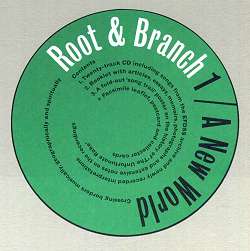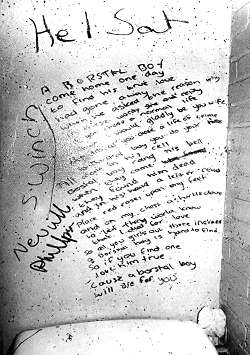 All OK so far. Now, what of the reality?
All OK so far. Now, what of the reality?
A New World
EFDSS No Number?
Another completely new venture from the EFDSS, hot on the heels of three fine, interesting and - most importantly - rather different from what we might have expected, CD releases. Might it be time to review my more than 30-year-old decision to have nothing more to do with the Society?
That may be for the future, let's turn to the present - what exactly is Root and Branch 1 / A New World? First the concept, then the reality. It is a new publication exploring the diversity and richness of English roots and traditional music. It is produced for the EFDSS by Unknown Public, the company behind the award-winning creative music journal on CD. Root & Branch is published twice a year and comes in a handsomely designed package that includes full length CD, articles and essays, facsimiles and photographs. A thematic thread links the text, graphics and music. This first issue of Root & Branch is built around songs that tell of the experiences and emotions of people when they are uprooted geographically, spiritually and musically.
That - compiled from the pre-release publicity and Press Release - covers more or less what the intentions are. The essays and introduction, together with notes on the 20 songs on the CD come in an 18-page booklet, which includes this further conceptual information:
The principal aims of Root & Branch are:
- to focus attention on the folk tradition: its songs, customs, music, stories, performers and field workers
- to entertain, inform and delight a broad audience
- to encourage new generations of listeners
- to embrace the depth, variety and richness of traditional music - past and present, global and local
- to increase access to the Vaughan Williams Memorial Library and its wealth of resources
 All OK so far. Now, what of the reality?
All OK so far. Now, what of the reality?
Root & Branch 1 comes in an A4 grey card folder ... one is reminded of the old grey-covered Leader classics of the 1970s - but while they were 'luxury' presentations, the adjective which springs to mind here is 'utility'. The front cover bears the logo shown on the right. This is the "handsomely designed package" of the publicity sheets.
Opening the 10mm thick folder we find rather less than a package of this size might have led us to expect, and when the various publicity sheets and order forms have been removed we are left with: a CD in a rather flimsy card case, the above-mentioned - and at 9½" x 6¾", very oddly sized - booklet, a single folded sheet facsimile of 'Hints to collectors of Folk Music', two 'bubblegum cards', a post-card sized photo of The Borstal Boy text written on a Kentish toilet wall, and the song trail in A2 poster form on the 'roots and branches' of the song The Unfortunate Rake. The first impression is that this is not a great deal to get for the selling price of £18.00 - or £16 if you decide to shell out £32 for the first two issues.
The second impression is that it all looks a bit dull - grey, white, red and green are the only colours used, along with black text ... oh, and there's a narrow dark blue edge to the bubblegum cards. All the graphics are in tones of a single colour. Actually, the booklet cover is nice and bright, but strangely, the cover seems reversed - what looks like the front cover is on the back, leaving a rather dull photo of Sharp's first American notebook for the front. Further inspection reveals that it's all rather nicely produced and laid out ... but it's not very visually stimulating (a bit like MT, I suppose!)
The third impression - having read all the contents - is that (again like MT) there's a lot of fascinating stuff here. The booklet starts with an introduction and overview of the issue theme by Vic Gammon, entitled 'Crossing Borders', which is a slightly less apt heading for the booklet contents than that of the Issue itself. All four of the essays are more concerned with experiences in 'A New Land' than they are with the idea of borders being crossed.
The first and longest of these is by Mike Yates, which the pre-publicity had told us would be about his Appalachian collecting experiences. Titled 'On Collectors and Collecting', at least half of it is about his and others' experiences in England. It contains a good deal of interesting material - though perhaps not as coherently edited as it might have been. He ends: "When I began to look for folk songs I was told by a number of people that I was wasting my time, that there were no more singers left to be discovered. And yet, clearly, there were people around who continued the tradition. Times change. Social conditions change. Just as past generations relied upon the printed broadsides for the texts of their folk songs, it could be that today's singers will learn their tradition from recordings such as these." Well said!
Andrew Cronshaw's brief piece on 'Swedes in Dakota' I found rather less interesting - and Swedes are barely mentioned and Dakota not at all ... though the title does connect with one of the songs on the CD. Actually it's about the Nordic emigrations into the Midwest. (Did you know that almost one fifth of the entire population of the Nordic countries emigrated during the period between the mid-19th century and the Great War - mostly to north America?)
'A L Lloyd in Australia' is by Dave Arthur - not the first name on many people's list of iconoclasts, I'd have thought ... but there's a lot of good critical writing here. A great deal of what Dave has to say is extremely interesting - particularly as Bert was such an enigmatic figure in many ways - and he packs a stack of information into a piece which is only just over three pages in length. As well as dealing with Bert's time in Oz, he also manages to include a mini-biography of the earlier part of his life - fascinating stuff! The best of the written material in the package, in my view.
Lastly, we have a short extract from Shirley Collins's forthcoming autobiography 'America Over the Water' - the story about Lomax's attempts at recording an Old Regular Baptist meeting in Kentucky, which I imagine will be familiar to most MT readers. The rest of the booklet is made up of four pages of song/performer notes. Given that each gets only a 40mm wide column, they do a pretty fair job.
Leaving the booklet now, we have the Song Trail in poster form, created by David Atkinson, on the roots and branches of the song The Unfortunate Rake. This is visually the best piece in the package, and contains the words of nine versions of the song, ranging from My Jewel, My Joy of around 1790, to a Pete Elliott Soldier Cut Down of 1969, by way of a 19th century Buck's Elegy, a St James' Hospital and Infirmary and a 1950s American parody, The Lineman's Hymn. Six of the songs have tunes in staff notation as well.
The facsimile of Kate Lee's 'Notes to Collectors' dating from 1898 is of historical interest, but beyond showing what a down-to-earth and sensible woman she was, there's not a lot to surprise or amuse us here. Her Note VI is rather modern: "It is important to obtain all information as to the title and history of the song, and the name of the tune, so far as the singer knows them, and in all cases the name and address of the singer should be given to the Society,  as well as the source from which he learnt the music." A good number of later collectors could have borne that advice in mind to advantage.
as well as the source from which he learnt the music." A good number of later collectors could have borne that advice in mind to advantage.
The post-card in the pack is a good one. It's that great photo of a Maidstone youth club bog wall with the words of the song The Borstal Boy written on it. The reverse gives details of the area, the club in 'The Bug Hut', the Approved School system and the song - a remarkably close relative to Died for Love or The Butcher Boy - and its complete text. This is a very worthwhile inclusion - and most appropriate, since The Butcher Boy appears on the accompanying CD.
The aforementioned 'bubblegum cards' (Martin Frost's term, not mine) are two examples of a series of 55 collector cards entitled 'Images of Tradition'. They're 70 x 95mm cards with a good photo on the front and a couple of paragraphs about the subject on the back - nicely done, though I don't imagine they'll prompt too many 'swapsies' encounters at folk festivals throughout the land next summer ... but you can never tell with folk. What does strike me as strange is the choice of images for Numbers 1 & 2 of the series ... what would you guess? Cecil Sharp would be a pretty likely contender for No 1, or what about John England? The Coppers? Dear William? No - it would seem that the editors gave no thought to which of their 55 images should be first among equals. In other circumstances this might be considered praiseworthy, but it would seem to me that, given the Society's wish to show itself to be pushing at the doors on the new Millennium and a much changed organisation from that of the '60s and '70s, they might have felt that some sort of statement could be made by their selection of images and their order of presentation. But Martin Frost says it never occurred to them - so Number 1 is A L Lloyd and Number 2 is Mary Neal (so that's one in the eye for poor old Cecil, there!)
Let's now turn our attention to the one remaining item - the 69 minute, 20-track CD - which includes songs that have famously travelled the English-speaking world, and some that are less well-known. Singers include Frank Hinchliffe, Walter Pardon, Johnny Doughty, Doc Watson, Almeda Riddle, Fred Whiting, Melcina Smith and Elias Frazer, I D Beck, Doug Wallin, Evelyn Ramsay, Cara Dillon, Enoch Kent, Paul Brady, Cathal McConnell, Carl Bruce and Helen Chadwick.
Cara Dillon, Enoch Kent, Paul Brady, Cathal McConnell, Carl Bruce and Helen Chadwick.
It's not only the booklet that has a quirky cover - this is the CD's front, and the title is on the back. Yes, it's a Revox A77, described as "favoured by many collectors and musicians in the 1970s." A borrowed one sits looking at me as I type this. A photo of a Nagra III portable adorns the Shirley Collins article, too ... strange stuff!
But the contents are almost entirely wonderful! A few tracks don't appeal to me, but - given Root & Branch's intention of appealing to a far wider audience spectrum than MT might be considered to do - this is hardly surprising, or objectionable.
I'll deal with these tracks first. Cara Dillon (from Oige and now Equation) is on track 1 to appeal, I imagine, to the youth/Celtic market. She sings Van Deiman's Land as if she'd learned it the day before the recording - with absolutely no emotional dynamics from line-to-line or verse-to-verse. Despite being unaccompanied and in free rhythm, she uses no rhythmic variations and precious few melodic ones - when you've heard verse 1, you've heard the song!
Paul Brady sings The Green Fields of Canada on a recording from 1985 - by which time he'd largely given up singing traditional songs, I think. It features a very long whistle intro, and whistle and pipes outro, and lush orchestral synth backing throughout. The singing, when you can concentrate on it, seems good - in the modern manner - but only good. As one who loved Brady's singing in the 1970s, I find this track a great disappointment. Anyone who has heard Paddy Tunney's benchmark recording is likely to find the present offering nothing short of lamentable.
The final track I find quite unfathomable. Helen Chadwick, an unfamiliar name to me, sings Who Am I? to her own melody, apparently "inspired by the singing of Frankie Armstrong". The words are a Robert Graves translation of Amergin, "thought to be the oldest poem in the Irish language", and the song was made for a performance of the story of Talliesin, the Welsh bard. If this conjures a picture of Celtic twighlight viewed through a confused New Age miasma for you, then we are of the same mind. The result is something I just can't listen to.
Now on to the wonderful stuff! One of the things I like very much about this record is that there's no clear line or disjunction between the tradition and the revival - in fact most performers fall into the 'para-trad' category that I've mentioned elsewhere in MT's pages, and it is amongst these that I find my favourite performances here.
![]() Cathal McConnell sings The Shores of Lough Bran - a performance I cannot imagine being bettered by anyone (sound clip). I remain astonished that I have reached my advanced age without owning any records of this man - an omission I intend to remedy shortly. (Score 1 to Root & Branch's avowed intentions) Doc Watson records I do have, from way back - and, consequently,
Cathal McConnell sings The Shores of Lough Bran - a performance I cannot imagine being bettered by anyone (sound clip). I remain astonished that I have reached my advanced age without owning any records of this man - an omission I intend to remedy shortly. (Score 1 to Root & Branch's avowed intentions) Doc Watson records I do have, from way back - and, consequently, ![]() I haven't listened to them for years. St James' Hospital shows me what I've been missing all this time, and reminds me what a consummate performer he is (sound clip). (Score 2 to Root & Branch) Bert Lloyd's Jim Jones urges me to learn this fabulous song with its "smouldering sense of vengefulness", but to use Mick Slocum's far-better tune. Melcina Smith and Elias Frazer, from Tortola in the Virgin Islands, sing The Butcher Boy absolutely delightfully - and remind us that Died for Love is only the second half of the song.
I haven't listened to them for years. St James' Hospital shows me what I've been missing all this time, and reminds me what a consummate performer he is (sound clip). (Score 2 to Root & Branch) Bert Lloyd's Jim Jones urges me to learn this fabulous song with its "smouldering sense of vengefulness", but to use Mick Slocum's far-better tune. Melcina Smith and Elias Frazer, from Tortola in the Virgin Islands, sing The Butcher Boy absolutely delightfully - and remind us that Died for Love is only the second half of the song.
And finally, there's the 'Featured Singer' - a concept not covered in the pre-publicity, or in the booklet. In this Volume it's Frank Hinchliffe from Yorkshire - and it's definitely Score 3 to Root & Branch for presenting a much neglected and very worthwhile singer. Two of his three songs (Edward and Wild and Wicked Youths) fit into the 'theme' - the former being spread across much of the world and the latter dealing with Transportation. It's not explained whether the 'Featured Singer' is selected because his/her songs suit the theme of the Volume, ![]() or whether this feature is a separate and unconnected addition. Whatever the case, Frank is a delight to listen to - a very good singer, and an absolutely gorgeous accent! (sound clip - The Pear Tree)
or whether this feature is a separate and unconnected addition. Whatever the case, Frank is a delight to listen to - a very good singer, and an absolutely gorgeous accent! (sound clip - The Pear Tree)
All in all, this package is first-class - utterly intriguing, thought-provoking, pigeonhole exploding ....... A great deal of the singing is wonderful and some is just stunning. The few aspects I didn't enjoy will doubtless please many other listeners, and I can't imagine anyone who won't find at least half of it essential. This Volume is a very good first offering in the series, an indicator of high quality to come, and leaves me looking forward to March 2000 and Volume 2. When it does arrive, I hope it's a bit more "hansomely packaged" than this, with rather more visual appeal, with the CD in a proper jewel case, with a proper catalogue number, and the booklet of a more 'standard' size. Some users may wish to keep the CD in the rack with their others, and the booklet on their bookshelves.
My only real concern is about the price, which does seem a bit steep. However, the 2 volume subscription does include membership of the Root & Branch CD Club - a mail-order scheme offering an introductory £5 off the EFDSS records and regular discounts on CDs from some other labels, including the Unknown Public releases. Well worth checking out from the EFDSS (Tel: 0171 486 2206), or Root & Branch, FREEPOST RG 2558, P O Box 354, Reading RG1 5ZZ (Tel: 0207 402 2789).
Rod Stradling - 6.11.99
| Top of page | Home Page | Articles | Reviews | News | Editorial | Map |